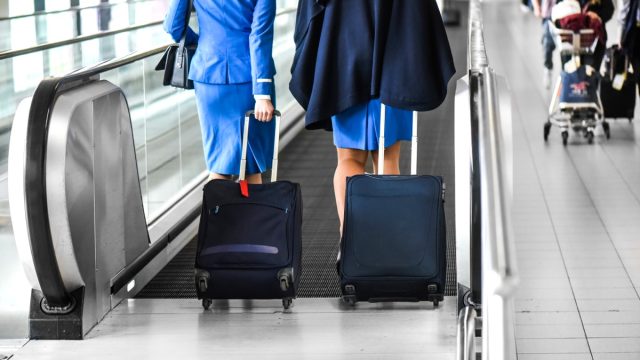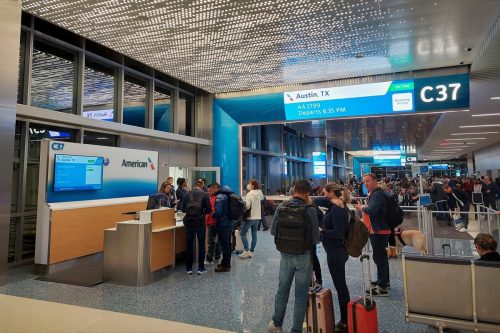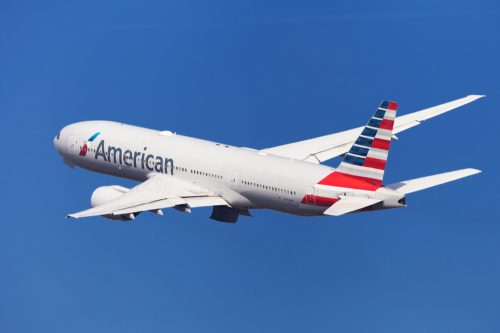American Airlines Flight Attendants Vote to Strike—What That Means for Your Flights
Thousands of union workers are pushing for the carrier to provide better wages.

It's been a summer of strikes, with workers making waves across multiple industries. The writers' and actors' strikes are shaking up the entertainment sector, while the postal industry has faced USPS protests and a potential UPS strike averted at the last minute. Now, your travel plans could be in jeopardy, as American Airlines flight attendants have just voted to authorize a strike. Read on to discover what that means for future flights.
RELATED: Travelers Are Boycotting Southwest Over Boarding Change.
American Airlines flight attendants are pushing for pay raises.

The Association of Professional Flight Attendants (APFA) is currently working to negotiate better wages for more than 26,000 American Airlines flight attendants. Their five-year contract became amendable in Dec. 2019, and the union started negotiations with the carrier in 2018 before they were shut down because of the pandemic, Forbes reported.
Talks resumed in 2021 but an agreement has not yet been met, and now they're at a "heated point in negotiations," Charlotte APFA President Scott Hazlewood told the magazine on Aug. 30.
On March 7, the APFA Negotiating Committee presented their economic proposal to American Airlines. The proposal indicates that the union is demanding an initial 35 percent raise for flight attendants, which could range anywhere from $40 to $93 more per hour depending on a worker's years of service. The APFA is also asking for a 6 percent annual increase every year following the initial raise.
RELATED: American Airlines Slammed for "Bad" New Upgrade Policy.
Flight attendants just voted to authorize a strike.

Nearly six months after the APFA released their wage demands, American Airlines flight attendants are now trying to put more pressure on the carrier to approve the pay raises. In an Aug. 30 press release, the APFA announced that 99.47 percent of participating flight attendants had just voted in favor of authorizing a strike.
"Today, we sent a clear message to American Airlines management: We are fired up and ready for a contract. They ignore this strike vote at their peril," APFA National President Julie Hedrick said in a statement. "Our contributions to the success of American Airlines must be recognized and respected."
A walkout is unlikely to happen anytime soon.

That doesn't mean you're going to see American Airlines flight attendants walking off planes tomorrow, however. Instead, the vote simply authorizes APFA leadership to call for a strike "if contract talks do not yield significant improvement," the union explained in its release.
But even then, a walkout would not be immediate. Federal law makes it difficult for airline unions to conduct strikes, according to CBS News. As the news outlet explained, the Railway Labor Act requires that federal mediators decide that further negotiations are pointless before a strike can occur—and that rarely happens.
"We cannot strike until released by the National Mediation Board and following a thirty-day cooling-off period," APFA stated in its release. "But if management continues proposing concessions coupled with meager improvements to compensation and retirement, we will not hesitate to request a release to strike if necessary."
RELATED: TSA Issues New Alert on What You Can't Bring Through Security.
Here's what a strike would look like for travelers.

If an agreement is not met and the APFA is released from negotiations by the National Mediation Board, the 26,000 unionized American Airlines flight attendants can strike after the 30-day cooling-off period. But that would likely be done through targeted job actions and not an actual full strike, View from the Wing reported.
The APFA has made it clear that a strike can "take on many forms," according to an FAQ section on its website. "A traditional strike includes all workers walking off the job, however intermittent strikes targeting certain flights provide management with less certainty and have proven more effective," the union states.
In other words, it is more likely that the union would target specific flights on certain days rather than striking across the board, according to View from the Wing. Most flight attendants would still be working most of the time, which minimizes their financial harm from a strike.
Nevertheless, such an action could still severely impact American Airlines' profits by creating uncertainty over potential flight cancellations—causing customers to book flights with a more stable carrier instead of American.
RELATED: For more up-to-date information, sign up for our daily newsletter.
American Airlines said it expects to reach an agreement with the union.

A strike will not occur at all if an agreement is met—which is what American Airlines is anticipating. When Best Life reached out to the carrier, a spokesperson provided a statement indicating that the carrier is continuing to meet regularly with the APFA, and is working to reach a fair agreement with the union.
"We're proud of the progress we've made in negotiations with the APFA, and we look forward to reaching an agreement that provides our flight attendants with real and meaningful value," American Airlines said in its statement.
The airline added, "We understand that a strike authorization vote is one of the important ways flight attendants express their desire to get a deal done. The results don't change our commitment or distract us from working expeditiously to reach an agreement."





















